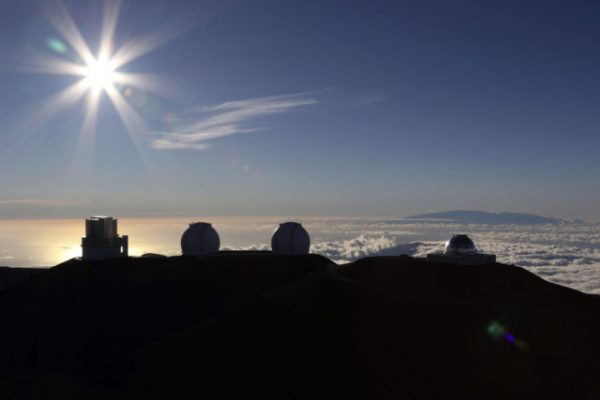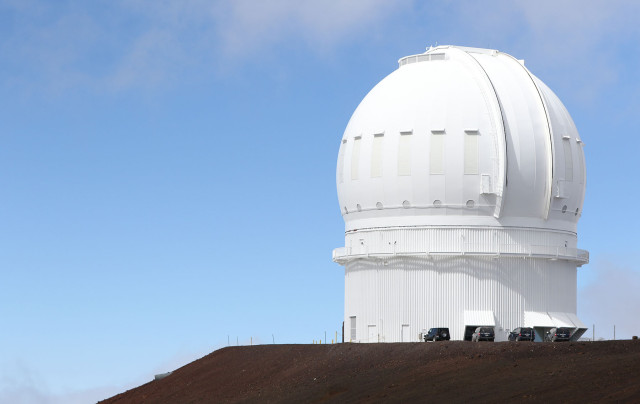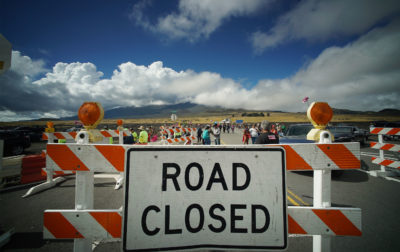Dozens Of Astronomy Projects Are On Hold At Empty Observatories – Honolulu Civil Beat
On Tuesday morning, a technical crew tried to get up Mauna Kea to perform maintenance on the Gemini observatory.
The observatory relies on gaseous helium to cool two instruments but the cooling system had become unstable. Technicians hoped to get up the mountain to shut down compressors and do other work to prevent damage to the instruments and cooling system.
But as they drove up the mountain, the crew was stopped by protesters who have set up camp at the base of Mauna Kea Access Road in an attempt to block construction of another observatory, the Thirty Meter Telescope.
A spokesman for the protesters said he told the car’s occupants that they’d be let through if the state allowed one car of cultural practitioners up the mountain to pray. The state didn’t agree. The technical crew drove away.
All kinds of work is not getting done at the Mauna Kea observatories since their staffs were evacuated last week. All scientific activities at the observatories have been suspended, throwing off dozens of scientific projects with global implications.

Astronomy work at the Mauna Kea telescopes has been shut down because protestors are blocking the access road and preventing staffs from getting to their work sites.
AP
The state shut down Mauna Kea Access Road in hopes of facilitating the beginning of TMT construction. Since then, both the authorities and the protesters have put up checkpoints that limit who can go up the mountain.
Hawaiian cultural practitioners don’t want to let astronomers up the mountain unless they can go too.
Decades-Long Projects
“Mauna Kea is one of the most scientifically impactful sites on the planet,” says John O’Meara, chief scientist at W.M. Keck Observatory, one of several on the mountain. “We have very, very high-impact science that’s the kind of stuff that shows up in The New York Times next week that is not being done.”
O’Meara says Keck Observatory puts out the equivalent of one high-impact scientific paper per day. Some projects — known as programs — require decades. Others can be observed in an instant, but require vigilance. At a minimum there are at least two programs ongoing per night at Keck, one of more than a dozen observatories on the mountain.
Some of the projects at Keck Observatory that lost observation time include two observations of super-massive black holes and transits of exoplanets in front of their host stars. Observation teams developing new technical instruments also paused their work.
“We helped kill Pluto from being a planet,” O’Meara said. “Even if we were losing one science project, that one science project could be the next Nobel Prize.”

Scientists worry that important studies are being harmed because of the unprecedented shutdown of all observatories at the same time.
Cory Lum/Civil Beat
It’s not easy to shift work to another telescope, O’Meara said. Mauna Kea’s “altitude and the stillness of the atmosphere is unique in the world to be doing this type of science.”
It’s not the first time work at the observatories has been paused. Bad weather interrupts observations and so do technical malfunctions. A broken shutter in 2012 put the Canada-France-Hawaii Telescope out of commission for 65 days.
But what’s happening now is unprecedented. It’s the longest stretch of time in the 50-year history of astronomy in Hawaii that all the observatories have been offline, according to a spokeswoman for Mauna Kea Observatories.
‘We’re Going To Work With What We Have’
The projects that are suspended are numerous and wide-ranging. Research at the Subaru Observatory includes direct imaging of exoplanets and searching for earth-type exoplanets. At UKIRT Observatory, scientists have been observing distant supernovae, exploded stars, which fade over time.
Astronomers at the UKIRT Observatory have also been observing the TRAPPIST-1 system, a star system with seven earth-sized planets in orbit. Three are considered habitable because they have water.

Protesters and law enforcement both have checkpoints on the Mauna Kea Access Road.
Cory Lum/Civil Beat
At the James Clerk Maxwell Telescope, operated by East Asian Observatory, scientists have been studying the birth of stars to gain more insight on how our solar system was created.
Professional astronomers aren’t the only ones affected. Summer college interns’ projects have been interrupted. Graduate students may have to delay their studies due to the need for more data.
At the Canada-France-Hawaii Telescope, astronomers have been tracking the paths of asteroids.
“By observing them many, many times you can recalculate their orbit and make sure that we know their trajectory very well,” explains Laurie Rosseau Etton, a resident astronomer.
She is in the midst of a long-term project observing star formation in nearby galaxies. Her project may be delayed depending on how long the road blockage lasts.
“The data that we are not observing right now might not ever be observed,” she said. “We’re going to work with what we have.”
While asking for your support is something we don’t like to do, the simple fact is that our reporters, our journalism, and our impact rely on it. Since lifting our paywall and becoming a nonprofit in mid-2016, our local newsroom has benefitted from a stream of charitable support from people who want our type of journalism to survive. People like you who understand that our work is essential to a better-informed community. If you value the work of our journalists, show us with your tax-deductible support.





